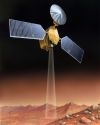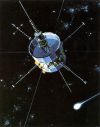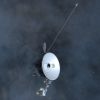Emily Lakdawalla • Aug 30, 2010
What's up in the solar system in September 2010
This month there will be approximately a hundred different planetary science meetings (a list of which is at the end of this post). In the meantime, business goes on as usual in space, with the biggest event this month being the start of Deep Impact's Encounter Phase with comet 103P/Hartley 2. It's headed for a 700-kilometer flyby on November 4. Also, you may want to wander outside and look up on September 18, which has newly been named "International Observe the Moon Night" (further details are below, in the Lunar Reconnaissance Orbiter mission update). Here's the rundown of what's happening across the solar system:
In the inner solar system:
 NASA's MESSENGER spacecraft is cruising along, with only 199 days remaining until Mercury orbit insertion (which is planned for March 18, 2011). Check their gallery for their latest image releases, which seem to be coming out twice a month or so these days.
NASA's MESSENGER spacecraft is cruising along, with only 199 days remaining until Mercury orbit insertion (which is planned for March 18, 2011). Check their gallery for their latest image releases, which seem to be coming out twice a month or so these days.
 ESA's Venus Express is quietly orbiting our sister planet, under an extended mission proposed to last through 2012. I've heard no news lately but there is a Venus Exploration Analysis Group (VEXAG) meeting in Madison, Wisconsin this week, which is preceded by a three-day workshop about "Venus, Our Closest Earth-like Planet: From Surface to Thermosphere - How does it Work?", whose program features lots of Venus Express science talks. And there's going to be a public event at 7 pm tomorrow featuring Jan Smit, David Grinspoon, and our own Bill Nye the Science Guy; if you're anywhere near Madison, plan on attending!
ESA's Venus Express is quietly orbiting our sister planet, under an extended mission proposed to last through 2012. I've heard no news lately but there is a Venus Exploration Analysis Group (VEXAG) meeting in Madison, Wisconsin this week, which is preceded by a three-day workshop about "Venus, Our Closest Earth-like Planet: From Surface to Thermosphere - How does it Work?", whose program features lots of Venus Express science talks. And there's going to be a public event at 7 pm tomorrow featuring Jan Smit, David Grinspoon, and our own Bill Nye the Science Guy; if you're anywhere near Madison, plan on attending!
 JAXA's Akatsuki en route to join Venus Express at the second planet. It is planned to arrive at Venus on December 7!
JAXA's Akatsuki en route to join Venus Express at the second planet. It is planned to arrive at Venus on December 7!
 JAXA's IKAROS, too, is flying toward Venus, and according to this kawaii animation, it will pass Venus (without entering orbit) on December 18. I am not sure what, if anything, the spacecraft will be able to do to mark this event. (By the way, "kawaii" is a word I learned during the Hayabusa landing, and it means "cute" -- an aesthetic that has turned into high art in Japan.)
JAXA's IKAROS, too, is flying toward Venus, and according to this kawaii animation, it will pass Venus (without entering orbit) on December 18. I am not sure what, if anything, the spacecraft will be able to do to mark this event. (By the way, "kawaii" is a word I learned during the Hayabusa landing, and it means "cute" -- an aesthetic that has turned into high art in Japan.)
 NASA's Lunar Reconnaissance Orbiter is busily mapping the Moon from its science orbit. My favorite recent one is this striking view of the boundary between the central peak of Tsiolkovskiy crater and its flooding mare basalt. Don't forget to check the LOLA image of the week site too. Also, the mission is promoting an event that I just learned about, International Observe the Moon Night, on September 18. It seems this year is just a pilot event; the coolest IOMN sub-event I found on their website was a lunar photo contest, with entry categories for both beginners and experienced photographers. The contest closes on September 23. It's not clear what the prize(s) are, beyond bragging rights, but I'll look forward to seeing the entries.
NASA's Lunar Reconnaissance Orbiter is busily mapping the Moon from its science orbit. My favorite recent one is this striking view of the boundary between the central peak of Tsiolkovskiy crater and its flooding mare basalt. Don't forget to check the LOLA image of the week site too. Also, the mission is promoting an event that I just learned about, International Observe the Moon Night, on September 18. It seems this year is just a pilot event; the coolest IOMN sub-event I found on their website was a lunar photo contest, with entry categories for both beginners and experienced photographers. The contest closes on September 23. It's not clear what the prize(s) are, beyond bragging rights, but I'll look forward to seeing the entries.
On to Mars:
 Out at Mars, it's midwinter in the southern hemisphere, (it's currently Ls 140.9°), which means that the rovers' nights, though long, are getting shorter every sol. Today it is Mars Exploration Rover Spirit sol 2367 and Opportunity sol 2346. Spirit has still not been heard from since sol 2210 (March 22). The orbiters continue to listen for signals from Spirit during scheduled passes, and the Deep Space Network also listens every day. Opportunity is steadily driving eastward, eating up the kilometers separating her from the rim of Endeavour crater; lots of cool features are now appearing on the horizon, many of which are located on the far rim of Endeavour, which just boggles my mind. Here is Eduardo Tesheiner's latest route map and Google Earth kml file for Opportunity.
Out at Mars, it's midwinter in the southern hemisphere, (it's currently Ls 140.9°), which means that the rovers' nights, though long, are getting shorter every sol. Today it is Mars Exploration Rover Spirit sol 2367 and Opportunity sol 2346. Spirit has still not been heard from since sol 2210 (March 22). The orbiters continue to listen for signals from Spirit during scheduled passes, and the Deep Space Network also listens every day. Opportunity is steadily driving eastward, eating up the kilometers separating her from the rim of Endeavour crater; lots of cool features are now appearing on the horizon, many of which are located on the far rim of Endeavour, which just boggles my mind. Here is Eduardo Tesheiner's latest route map and Google Earth kml file for Opportunity.
 ESA's Mars Express mission recently posted an especially lovely photo of Orcus Patera. It should be in the middle of some more Phobos encounters, but ESA's been mum on that topic. There haven't been any new Mars Webcam photos since the ones I posted of the north polar cap early this month.
ESA's Mars Express mission recently posted an especially lovely photo of Orcus Patera. It should be in the middle of some more Phobos encounters, but ESA's been mum on that topic. There haven't been any new Mars Webcam photos since the ones I posted of the north polar cap early this month.
 Mars Reconnaissance Orbiter is humming along in normal science operations. The latest MARCI weather report indicates only few dust storms and light cloud cover across Mars in the past week. As always, check in on the latest captioned image releases from HiRISE for your dose of spectacular photos from Mars. The latest image release set includes a small digital terrain model of part of the area traversed by Opportunity, centered on Victoria crater; start your engines, animators! The topography in this digital terrain model is incredibly detailed; the whole area is crossed by only four MOLA ground tracks. Those MOLA tracks can be used to establish the base elevation of the plains around Victoria as being -1376 meters on the west side of the crater and -1384 meters on the east side of the crater. Did you know that the crater's eastern rim was about 10 meters lower than the western rim? I didn't.
Mars Reconnaissance Orbiter is humming along in normal science operations. The latest MARCI weather report indicates only few dust storms and light cloud cover across Mars in the past week. As always, check in on the latest captioned image releases from HiRISE for your dose of spectacular photos from Mars. The latest image release set includes a small digital terrain model of part of the area traversed by Opportunity, centered on Victoria crater; start your engines, animators! The topography in this digital terrain model is incredibly detailed; the whole area is crossed by only four MOLA ground tracks. Those MOLA tracks can be used to establish the base elevation of the plains around Victoria as being -1376 meters on the west side of the crater and -1384 meters on the east side of the crater. Did you know that the crater's eastern rim was about 10 meters lower than the western rim? I didn't.
 NASA's Mars Odyssey remains the longest-lived spacecraft in orbit at Mars. You can see the latest from its THEMIS instrument here. I like this one of what look like inverted, dendritic channels -- weird. THEMIS principal investigator Phil Christensen is the main guest on this week's Planetary Radio.
NASA's Mars Odyssey remains the longest-lived spacecraft in orbit at Mars. You can see the latest from its THEMIS instrument here. I like this one of what look like inverted, dendritic channels -- weird. THEMIS principal investigator Phil Christensen is the main guest on this week's Planetary Radio.
Exploring Saturn:
 The NASA-ESA-ASI Cassini mission is approaching periapsis (closest approach) on Rev 137, a low-inclination orbit with about a 20-day period; the similar Rev 138 starts on September 12. The Looking Ahead article for Rev 137 says we have some cool ring observations to look forward to this week; in one set, Cassini will take advantage of Saturn's bulk to block the sunlight and allow it to stare at the F ring with the Sun nearly directly ahead -- those photos should be spectacular. There will also be a very good opportunity to photograph Dione from a distance of about 40,000 kilometers, on Friday, September 3. A more distant encounter with Enceladus happens on the 22nd, and then there's a more distant than normal targeted encounter with Titan on the 24th, which will lengthen the period of Cassini's orbit to 24 days. At the end of the month, Saturn will approach to within 3 degrees of the Sun, which means the mission won't be allowed to send commands to the spacecraft for about a week. I assume, though, that just as with previous solar conjunctions, Cassini will still attempt radio contact with Earth, and radio scientists will study the attenuation of the radio signal to learn more about the solar corona. The fact that we're close to conjunction explains why there have been relatively few images from Cassini lately; it's much harder to communicate with the spacecraft when it is so far away from Earth, all the way on the opposite side of the Sun.
The NASA-ESA-ASI Cassini mission is approaching periapsis (closest approach) on Rev 137, a low-inclination orbit with about a 20-day period; the similar Rev 138 starts on September 12. The Looking Ahead article for Rev 137 says we have some cool ring observations to look forward to this week; in one set, Cassini will take advantage of Saturn's bulk to block the sunlight and allow it to stare at the F ring with the Sun nearly directly ahead -- those photos should be spectacular. There will also be a very good opportunity to photograph Dione from a distance of about 40,000 kilometers, on Friday, September 3. A more distant encounter with Enceladus happens on the 22nd, and then there's a more distant than normal targeted encounter with Titan on the 24th, which will lengthen the period of Cassini's orbit to 24 days. At the end of the month, Saturn will approach to within 3 degrees of the Sun, which means the mission won't be allowed to send commands to the spacecraft for about a week. I assume, though, that just as with previous solar conjunctions, Cassini will still attempt radio contact with Earth, and radio scientists will study the attenuation of the radio signal to learn more about the solar corona. The fact that we're close to conjunction explains why there have been relatively few images from Cassini lately; it's much harder to communicate with the spacecraft when it is so far away from Earth, all the way on the opposite side of the Sun.
Exploring a Comet:
 NASA's Deep Impact's Encounter Phase with Comet 103P/Hartley 2 begins this month! There's been no recent news out of the mission but I will be watching and posting new stuff as I hear it. Closest approach will be at a distance of only 700 kilometers, a few minutes before 14:00 UTC on November 4. Observations will begin on September 5 and continue through November 25, which will mark the end of scientific observations for the Deep Impact extended mission. After returning all data from the comet encounter, Deep Impact will be decommissioned. For some great photos of Hartley 2, visit the University of Maryland's Amateur Observers' Program Hartley 2 gallery.
NASA's Deep Impact's Encounter Phase with Comet 103P/Hartley 2 begins this month! There's been no recent news out of the mission but I will be watching and posting new stuff as I hear it. Closest approach will be at a distance of only 700 kilometers, a few minutes before 14:00 UTC on November 4. Observations will begin on September 5 and continue through November 25, which will mark the end of scientific observations for the Deep Impact extended mission. After returning all data from the comet encounter, Deep Impact will be decommissioned. For some great photos of Hartley 2, visit the University of Maryland's Amateur Observers' Program Hartley 2 gallery.
Cruising from here to there:
 All systems on NASA's Stardust are "nominal" as only 168 days remain until its flyby of comet Tempel 1. Closest approach will happen at 8:42 p.m. PST on February 14, 2011, or 04:42 February 15 UTC.
All systems on NASA's Stardust are "nominal" as only 168 days remain until its flyby of comet Tempel 1. Closest approach will happen at 8:42 p.m. PST on February 14, 2011, or 04:42 February 15 UTC.
![]() NASA's Dawn is now in the asteroid belt for good, and is steadily thrusting with its ion engines, patiently propelling itself toward a rendezvous with Vesta in July 2011, only 325 days away.
NASA's Dawn is now in the asteroid belt for good, and is steadily thrusting with its ion engines, patiently propelling itself toward a rendezvous with Vesta in July 2011, only 325 days away.
 NASA's New Horizons has 14.35 AU to go to reach Pluto. It's still on course for a January to July 2015 encounter with the Pluto and Charon system. There are 1778 days left until Pluto closest approach.
NASA's New Horizons has 14.35 AU to go to reach Pluto. It's still on course for a January to July 2015 encounter with the Pluto and Charon system. There are 1778 days left until Pluto closest approach.
 ESA's Rosetta mission is preparing to hibernate from July 2011 to January 2014. The next object it'll encounter will be its goal, comet 67/P Churyumov-Gerasimenko; rendezvous is set for May 2014.
ESA's Rosetta mission is preparing to hibernate from July 2011 to January 2014. The next object it'll encounter will be its goal, comet 67/P Churyumov-Gerasimenko; rendezvous is set for May 2014.
 The International Cometary Explorer remains on course for a return visit to Earth in 2014. When it does, ICE can be returned to a Sun-Earth L1 halo orbit, or can use multiple Earth swingbys to encounter Comet Wirtanen during its near-Earth apparition in December 2018.
The International Cometary Explorer remains on course for a return visit to Earth in 2014. When it does, ICE can be returned to a Sun-Earth L1 halo orbit, or can use multiple Earth swingbys to encounter Comet Wirtanen during its near-Earth apparition in December 2018.
And beyond:
 Finally, NASA's Voyager 1 and 2 spacecraft are still going strong. I'm enjoying following the relatively active Twitter feed of Voyager 2, which also mentions the position of Voyager 1 once a day.
Finally, NASA's Voyager 1 and 2 spacecraft are still going strong. I'm enjoying following the relatively active Twitter feed of Voyager 2, which also mentions the position of Voyager 1 once a day.
Some other milestones to take note of this month, taken from JPL's Space Calendar:
- The Moon occults Venus on September 11.
- The Lunar Exploration Analysis Group annual meeting is in D.C. on September 14-16, overlapping with...
- The Outer Planets Assessment Group meeting, in Boulder, Colorado on September 16-17. Hope nobody's interested in both the Moon and outer planets!
- Mercury is at its greatest western elongation on September 19.
- The European Planetary Science Congress is on September 19-25 in Rome.
- Both Jupiter and Uranus are at opposition on September 21.
- Happy equinox on September 23!
- The MSL Landing Site meeting is on September 27-29 -- I hope to attend at least some of it. It's followed by the Mars Exploration Program Analysis Group meeting September 30-October 1
- Meanwhile, the International Astronautical Congress will be taking place in Prague on September 27-October 1.
Holy planetary science meetings, Batman!
Let’s Go Beyond The Horizon
Every success in space exploration is the result of the community of space enthusiasts, like you, who believe it is important. You can help usher in the next great era of space exploration with your gift today.
Donate Today

 Explore Worlds
Explore Worlds Find Life
Find Life Defend Earth
Defend Earth

